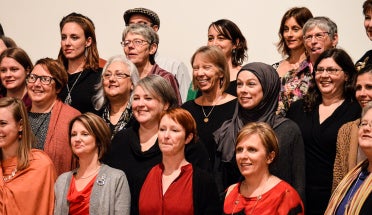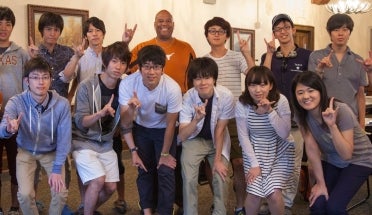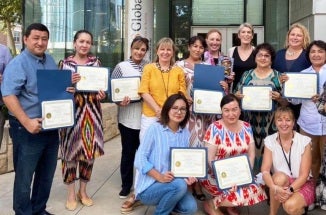
Teacher Feature: Melissa Ferro, English Language Center Instructor
- Jul 12, 2022
- English Language Center
- by Ellen Stader
[Editor's Note: This story is part of a Texas Global series celebrating the work of faculty members in the English Language Center at The University of Texas at Austin.]
Many international students and professionals who hope to improve their English-speaking skills find that classes are most effective when they’re informed by an understanding of cultural and linguistic diversity.
The English Language Center (ELC) at The University of Texas at Austin offers exactly this type of education, combining outstanding language-learning opportunities with abundant social and cultural immersion, executed with a keen awareness of students’ varying cultural, educational and linguistic backgrounds.
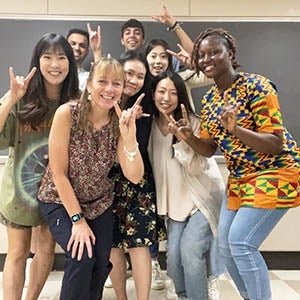
ELC instructor Melissa Ferro, Ph.D., has distinguished herself in the area of educational equity within this field, having designed and taught classes for students and English as a Foreign Language (EFL) teachers alike. Her most recent class was designed to help incoming EFL teachers create courses that appreciate and accommodate student diversity while also augmenting their own English-language skills.
To find out more about Ferro and her inclusive vision of multilingual and multicultural education, Texas Global asked about her background and teaching experiences at the ELC.
How did your background lead you to the position you’re in now, teaching for the English Language Center at UT Austin?
I think everyone’s life is a journey with unexpected twists and turns. Mine started as I struggled to find the right major in college, ending up with a train of college credits from different universities and 10 years in retail sales and management before I married into a Spanish family.
I realized that the things I enjoyed most about my retail career, such as leading teams and helping others achieve their goals, are what teachers do every day. So, at age 28, I decided to become a Spanish teacher—even though I didn’t know more than a handful of words in the language!
It was a crazy idea, but I was able to study abroad twice in Spain, which not only improved my oral and written communication skills in Spanish but also deepened my understanding of other cultures beyond anything I could have learned from a textbook.
After completing my B.A. in Spanish, I taught at George Mason University for 14 amazing years while earning my M.Ed. in K-12 curriculum and instruction and a Ph.D. in multilingual-multicultural education. In 2012, I took a position in GMU’s Pathway program, which prepares international students for university study, and immediately fell in love with teaching students from all over the world.
How did you become an English Language Center instructor at UT Austin, and how long have you taught there?
In 2015, my husband, our two cats and I moved from Virginia to London, England, which was a wonderful four-year experience. But when we moved back to the United States in August 2019, I didn’t know anyone at UT Austin.
I found Dr. Michael Smith’s email address on the Texas Global website and sent him my CV. About a week later, he called me in for an interview. A few days after that, I was on the UT campus teaching classes. I felt like I had hit the lottery.
Then the pandemic hit. I had to sit out a few semesters while our students were unable to travel to Austin. Thankfully, I received the call to return to teaching in the early summer of 2021.
What do you enjoy most about teaching English at the ELC?
Every 15 weeks, I get to meet new students from around the globe and help them achieve their goals. How many people get to say that about their jobs? I also love working with my colleagues. It is such an honor to work with a group of people who are so dedicated to excellence in everything they do.
What motivates you most, or what do you most hope to accomplish, in your teaching and working with ELC students?
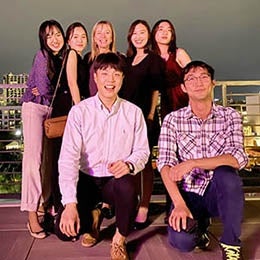
As an instructor, my role is to support my students through this part of their life journey. I enjoy learning about them and why they are studying English. I also think it’s important that they feel like they belong here—in my classroom, on the UT campus, and in the greater Austin community. It is very important that they have what they need as individuals to succeed.
What have you learned from your ELC students?
I learn from our students constantly. We have students from more than 36 countries. Their diverse linguistic and cultural backgrounds enrich my lessons all the time. It is an opportunity for all of us to further develop our intercultural awareness and communicative competencies.
How does the concept of educational equity apply in the classes you teach at the ELC?
In the field of multicultural education, the term “educational equity” is preferred to “equality” because treating all students equally—for example, providing them identical instruction, resources, and support—does not ensure a fair application of resources with respect to their individual needs or differences.
To illustrate this, I refer to a well-known metaphor about giving every patient who enters an emergency room the same box of Band-Aids. How is a box of Band-Aids a fair and useful way to treat all types of injuries or illnesses? In such a situation, there is equality, but not equity.
In Spring 2022, you taught a class on educational equity for 40 undergrad students from Hangzhou Normal University, an ELC partner. What can you tell us about the objectives and outcomes of the class?
The overall course goal was to advance the abilities of pre-service EFL teachers to create lessons that recognize and value student diversity while also improving their own language skills.
Since this was an online course with weekly Zoom meetings, I was thankful for the plenitude of resources available online, including equity frameworks and guidelines for lesson planning and inclusive instructional practices.
But there was one glaring caveat: These frameworks are designed for the context of teaching in the U.S. I had to adapt the course materials for a different culture of education while also addressing the students’ varying levels of English proficiency.
Before the first class meeting, I had a bit of anxiety because I had no idea what the students already knew about these topics—or if they even had any interest in the course. In the end, it all worked out very well.
Over four weeks, the students engaged with various web-based resources to learn and think critically about inequities related to physical and cognitive abilities, race, religion, national origin, and gender/gender identity. We explored how cultural and linguistic diversity is often subject to a teacher’s unconscious bias.
We also looked at how school systems often take a deficit approach to students with differences, viewing them collectively as problems needing to be fixed, rather than individuals who ought to be respected and valued.
Using platforms like Canvas Padlet and Flip (formerly Flipgrid), the students engaged with one another to discuss their own experiences, ideas and opinions related to the weekly readings and lectures. For example, they used Flip to share their knowledge about Chinese laws that protect the rights of students with disabilities and/or to share personal experiences related to this topic.
Their resulting video and text discussions generated more than 160 comments on social media, which amounted to more than 14 hours of engagement! Even more important, the students’ course evaluations reflected their positive experiences and personal growth.
Do you hope to create more classes like this in the future? Do you have other specific groups in mind for whom you’d like to tailor classes?
Definitely! I would welcome the opportunity to teach this course again. We’ve had groups of teachers from Mexico and Uzbekistan in recent years who would enjoy and benefit from this course.
One of the many things we do well is expanding and adapting our course offerings in response to requests from our ELC partner universities. I am excited to see what comes next for us at the ELC.

